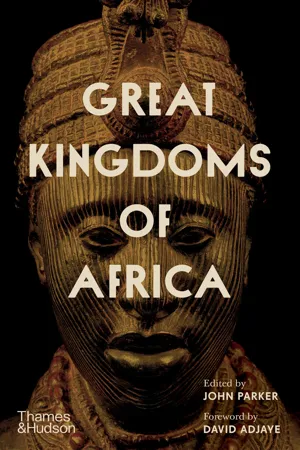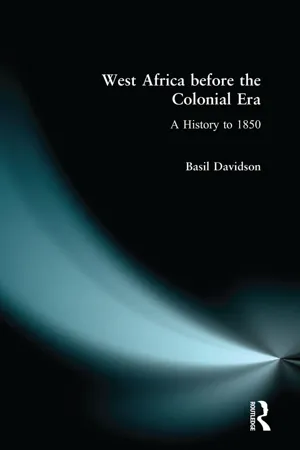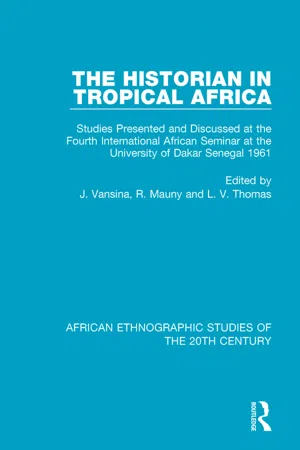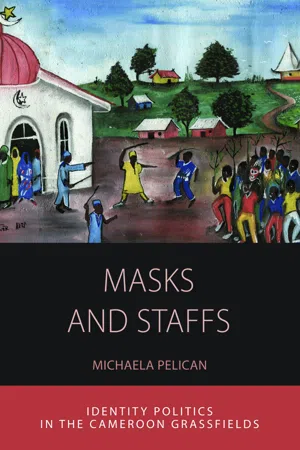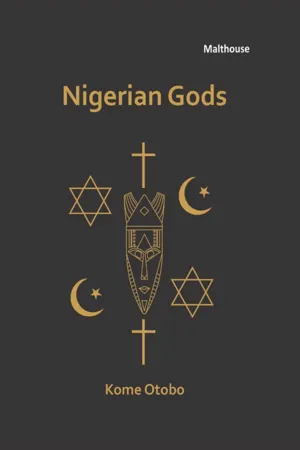History
Hausa Kingdom
The Hausa Kingdom was a group of states in West Africa that emerged around the 7th century. It was known for its complex system of government, trade networks, and cultural achievements. The Hausa Kingdom played a significant role in the trans-Saharan trade and had a lasting impact on the region's history and culture.
Written by Perlego with AI-assistance
Related key terms
1 of 5
7 Key excerpts on "Hausa Kingdom"
- eBook - ePub
- John Parker, David Adjaye(Authors)
- 2023(Publication Date)
- Thames and Hudson Ltd(Publisher)
CHAPTER 7FROM Hausa KingdomS TO THE SOKOTO CALIPHATE
Muhammadu Mustapha GwadabeWith a long history of state-building, urban development and cultural creativity, the Hausa region of West Africa is one of the most populous and well-studied parts of the continent. Occupying the central section of the Sudanic savanna zone between the Niger River to the west and Lake Chad to the east, kasar Hausa or ‘Hausaland’ today is encompassed by northern Nigeria and the southern parts of the Republic of Niger. In that historic heartland and in West Africa beyond, up to 40 million people speak Hausa as their mother tongue, and perhaps another 20 million as a second tongue, making it one of the continent’s most important languages.1 Over the course of the last millennium, what would emerge as kasar Hausa experienced a gradual process of political, economic and cultural evolution, resulting in features such as walled cities, a dynamic economy based on agriculture, craft production and trade, and political institutions characterized by powerful kings and sophisticated courtly cultures. The region’s city-states developed impressive military capabilities and a cultural ethos of the heroic mounted warrior, which not only shaped conflict between them, but also allowed for further territorial expansion. For a long time, Hausaland was little known to the outside world, forming something of a decentralized frontier between the more powerful kingdoms of Kanem-Borno to the east and Gao to the west. Yet by the sixteenth century, the region had emerged as a key crossroads of trans-Saharan trade routes and those extending across the savanna zone to the south of the desert. The leading Hausa Kingdoms, first Katsina, Kano and Zazzau and subsequently Zamfara, Gobir and Kebbi, had begun collectively to forge a distinctive identity and an influence in the wider region. That influence would further be enhanced by the collapse in 1591 of Songhay, which had expanded from its heartland of Gao to become the last of the sequence of great imperial states in the western Sudan (see chapter 2 ). Despite recurrent military conflict between – and sometimes within – the Hausa Kingdoms, the following centuries witnessed ongoing economic prosperity, demographic growth and the deepening influence of Islam.2 - eBook - ePub
West Africa before the Colonial Era
A History to 1850
- Basil Davidson(Author)
- 2014(Publication Date)
- Routledge(Publisher)
There were many Hausa cities engaged in trade and politics. Daura and Gobir, Katsina, Kano and Zaria – these are only five of the better-known names. Sometimes these states cooperated for their common good. Often they quarrelled. They never had a single government that ruled them all. They did not form a Hausa empire. Yet the Hausa states, generally more friendly with each other than with their non-Hausa neighbours, had influence and commercial power over a wide area of the eastern region.These states were in close and constant touch, sometimes by war but more often by peaceful trade, with the peoples of the forest lands along the West African coast, notably with the Yoruba and their wealthy neighbours. It was largely through Hausaland that the goods of the Yoruba country, especially kola nuts, went northward into the Western Sudan and across the Sahara to North Africa; and it was largely through Hausaland that the forest peoples could import the North African goods they needed.The Hausa achievement
Built in a fertile land, rich in skilled farmers and determined traders, the Hausa cities and states became a strong and stable part of the West African scene.They were deeply influenced by Muslim methods of government as practised in the neighbouring empires of Songhay and Kanem-Bornu. These methods tended to strengthen the power of kings at the cost of ordinary folk. Government taxes and tolls grew heavier. The needs of courts and armies weighed down on tax-paying citizens and the farmers of the countryside. Armouries glinted with the metal of expensive coats of chain-mail and fine helmets.By the 1440s there were even a few muskets in Hausaland, brought in by traders from Bornu who had got them from Egypt. And now the Muslim rulers began to use slave labour on a large scale. In 1450, for instance, the then ruler of Kano, Abdullahi Burja, a tributary vassal or under-king of the empire of Kanem-Bornu, sent out soldiers on raids for captives which are said to have brought him as many as 1,000 slaves a month. He is reported to have established no fewer than twenty-one settlements of royal slaves, each with 1,000 men. - eBook - ePub
- Toyin Falola(Author)
- 2023(Publication Date)
- Routledge(Publisher)
Mamluk Cairo, a Crossroads for Embassies: Studies on Diplomacy and Diplomatics, eds. Frédéric Bauden and Malika Dekkiche (Leiden: Brill, 2019), 658–682.- Davidson, A History of West Africa, 105.
- Michael G. Smith, The Affairs of Daura: History and Change in a Hausa State, 1800–1958 (Los Angeles: University of California, 1978).
- Mahdi Adamu, The Hausa Factor in West African History (Zaria: Ahmadu Bello University Press, 1978).
- Heinrich Barth, Travels and Discoveries in North and Central Africa (London: Longman, Brown, Green, Longmans, & Roberts, 1857), quoted in Hopkins, An Economic History of West Africa, 94.
- Bawuro M. Barkindo, ed., Kano and Some of Her Neighbours (Bayero: Ahmadu Bello University Press, 1989).
- John N. Panden, Religion and Political Culture in Kano (Berkeley: University of California Press, 2020), 432–435.
Passage contains an image
7 STATES AND EMPIRES
DOI: 10.4324/9781003198260-9Introduction
Right from its earliest origins, the development of human civilization/society has been driven by the insatiable needs of humans, which in the beginning consisted of a basic desire for survival: the search for food, shelter, and warmth. In this original quest for survival, humans, whose greatest obstacle was the environment, fashioned tools and pooled together into groups, establishing various modes of social (intra- and intergroup) interactions—kinship, citizenship, trade, and other forms of social partnerships—to improve their chances at an easier existence. With an ever-growing capacity to subdue and adapt to the environment to meet immediate needs, population expansions were recorded, which produced tensions and competition to acquire and control access to increasingly scarce resources.The next stage in political development in West Africa was sponsored by the availability and use of iron tools, which added another important dimension to social interaction. As certain groups acquired the capacity to compel others to do their bidding, society developed more complex forms of social organization and interaction, producing structures determined by individual capacities and the varying types of social contracts that emerged. - eBook - ePub
The Historian in Tropical Africa
Studies Presented and Discussed at the Fourth International African Seminar at the University of Dakar, Senegal 1961
- J. Vansina, R. Mauny, L. V. Thomas, Jan Vansina(Authors)
- 2018(Publication Date)
- Taylor & Francis(Publisher)
19 The central cult of each community would normally vest in the chief or his council; and political power was closely integrated with ritual sanctions and forms. The chief’s administrative power was, however, rudimentary, and depositions on ritual and other grounds were probably frequent.Such Hausa chiefdoms differed sharply, however, from the tribal societies around them. Their members would identify themselves with the capital and ruler, and might recognize their community of culture, language, values and organization with nearby chiefdoms. While other peoples would be difficult to assimilate as free members of Hausa society, and were therefore liable to tribute and slavery, the members of a defeated chiefdom might be easily incorporated into the victor’s expanding polity. Slavery, while certainly known, was neither widespread nor important, perhaps because Hausa lacked the strength or techniques for large-scale slave-raiding, as well as the incentive to capture slaves for sale or tribute.There is scarcely any mention of wars between members of the Hausa bakwai during this period. A common designation as Hausa was then unknown. Peoples described themselves as citizens of the chiefdoms to which they belonged. The states which survived the process of growth by incorporation must have initially been well beyond one another’s reach, and they could thus come into conflict only when their boundaries began to meet. The few internecine wars reported between Hausa bakwai during these centuries confirm this interpretation. Jernatata, a legendary ruler of Katsina, is said to have fought with Gobir,20 perhaps after Tuareg had driven these people southwards on to Katsina’s frontiers. A ruler of Kano, Yaji (1349–85), attacked Rano, which lay on his borders, with some success.21The first formative period of Hausa history really ended in 1350, a year after Yaji began to reign at Kano. By then all the main Hausa states had been established. Gobir had survived Tuareg threats of extermination and had moved into northwestern Hausaland. Katsina, Kano, Rano, Daura, and Biram were fairly well-defined units. Katsina had recently survived a change of dynasty, and perhaps a conquest, without disintegrating.22 Zazzau was recognizable as a territory, although not yet a unified state. The borders of these chiefdoms were beginning to meet, and with them their armies. Moreover at this date their long period of seclusion virtually ended. In 1353 Ibn Battuta passed by Gobir on his way to Takadda in Tuareg.23 ‘In Yaji’s time the Wongarawa (Mandingoes) came from Mele, bringing the Muhammadan religion.… The Sarki commanded every town in Kano country to observe the times of prayer. The Sarkin Gazarzawa (Barbushe’s successor) was opposed.’24 In Katsina also the ruler was converted to Islam by Mandingo divines; and the Suleibawa Fulani, who are partly Mandingo by origin, settled north of the city near Bugaji.25 - eBook - PDF
Women and Work in Northern Nigeria
Transcending Boundaries
- R. Pittin(Author)
- 2002(Publication Date)
- Palgrave Macmillan(Publisher)
The continued success of the realm was held to lie in large measure in the efficacy of the rites conducted, with fortune ultimately reposed in the person of the ruler, usually but not always a male. The early history of Hausaland, as exemplified in the creation myths and 'king' lists, is a portrayal of female political control, with a break in the tradition exemplified in the Bayajida legend, 2 which validates the authority of and lends authenticity to the Hausa states which are known as the Hausa bakwai (seven), the original seven Hausa states. Katsina is among the seven. Daura, the first of the seven Hausa states according to the legend, shows a tradition of matriarchy as manifested by the names of seventeen queens given as the earliest rulers of Daura (Palmer, 1928, vol. 3:142-3; Hogben and Kirk-Greene, 1966:154). The suggestion by A.E.V. Walwyn (Palmer, 1928, vol. 3:136-7) that the queen list is more a description of the institution of matriliny, later displaced by patrilineal descent, is unconvincing given the evidence that queens ruled elsewhere in the savannah, and the strong supportive mythology and history. The historical sources suggest the existence of early matriarchy, which subsequently gave way to male rule, but with an ideology which permitted the resumption of political power by women over both men and women. The seven 'legitimate' Hausa states share the tradition of the Bayajida legend, and at least five share also a history of political power exercised by women. 3 This is shown most clearly among the people never conquered by the Fulani, and in a less distinct form even within the Fulani Emirates formed during the Jihad. The political importance of women in the Habe kingdoms varied, but is most strikingly shown in the history of the kingdom of Zazzau, within which ruled the most famous of Habe queens, and perhaps the best known of Habe rulers, Queen Amina. - eBook - PDF
Masks and Staffs
Identity Politics in the Cameroon Grassfields
- Michaela Pelican(Author)
- 2015(Publication Date)
- Berghahn Books(Publisher)
This is because different criteria were, and still are, used by different people at different times to define who was or should be regarded as Hausa. Some people used purely historical claims to Hausa ethnicity, others used cultural traits and social values as their yardstick, while others still used religion plus language. There are also people who on very rare occasions prefer to use occupational specialization in commerce. (Adamu 1976: 5) Researchers diverge in their assessment of the Hausa ethnic category. Anthropologists who have studied Hausa in their homeland tend to characterize them as a linguistic group with a particular cultural system or civilization (e.g. Barkow 1972; Smith 1952; Sutton 1979; Wall 1988). Conversely, researchers working on the Hausa diaspora tend to comprehend them as political and economic interest groups that are organized along the criteria of religious affil-iation, occupational organization, settlement pattern and language (e.g. Cohen 1966, 1974; Salomone 1975c). Upon reading an early draft of this chapter, the 138 Masks and Staffs Hausa historian and anthropologist Murray Last commented as follows on the relevance of Hausa ethnicity in Hausaland and in the diaspora: My guess is that terms like hausawa [Hausa people], bahaush e [Hausa man] matter more in the peripheries of Hausaland and beyond – and your study is therefore fascinating for its care and skill in that context; for ethnicity matters in your world [the Cameroon Grassfields]. It matters too in some wider political contexts. But it is a different world from Hausaland itself, and the day-to-day talk of farmers and their wives and children in, say, the Kano or Katsina countryside. It is in the periphery that notions like ‘becoming Hausa’ (used by Salomone at a particu-lar political conjuncture) become important. The current trend in the Nigerian middle belt is marked more by ‘ceasing’ to be Hausa. - eBook - PDF
- Erubu Otobo(Author)
- 2023(Publication Date)
- Malthouse Press(Publisher)
Chapter 1 HAUSA GODS [The Hausa people comprise 30% of the Nigerian population according to the Central Intelligence Agency World Factbook, 2018 estimate] The Hausa people are predominantly found in Northern Nigeria and adjacent southern Niger. They constitute the largest ethnic group in the area, which also contains another large group, the Fulani, perhaps one- half of whom are settled among the Hausa as a ruling class, having adopted the Hausa language and culture. The language belongs to the Chadic group of the Afro-Asiatic (formerly Hamito-Semitic) family and is infused with many Arabic words as a result of Islamic influence, which spread during the latter part of the 14 th century from the kingdom of Mali, profoundly influencing Hausa belief and customs. A small minority of Hausa, known as Maguzawa, or Bunjawa, remained pagan. 1 BACKGROUND Many Nigerians identify the Hausa people* as followers of Islam, and Islam only, which is far from the truth, particularly once we take into account the migration theories that suggest their movement through North African countries like Egypt and even the Horn of Africa via Ethiopia. Their lack of knowledge can be attributed to the paucity of commonly available resources outside of the Internet. The relatively high costs of data also act as a deterrent to the usage of the Internet apart from the usual platforms of Facebook, Instagram and WhatsApp. It is unlikely that the average Nigerian will seek out information about the religious leanings of a tribe that is not their own, unless it is linked to a training course, a higher learning degree or similar. It is now an established fact that Islam was introduced to Nigeria as far back as in the eleventh century. The religion had already begun to make its 1 https://www.britannica.com/topic/Hausa * Estimates range from 66 to 68 million. Nigerian Gods 2 way through West Africa as traders sold their wares from country to country.
Index pages curate the most relevant extracts from our library of academic textbooks. They’ve been created using an in-house natural language model (NLM), each adding context and meaning to key research topics.
